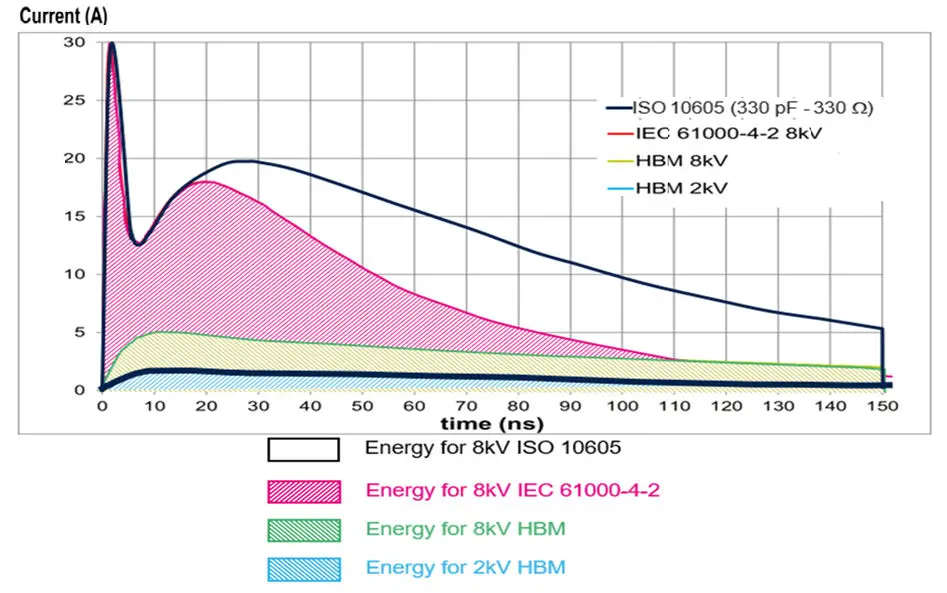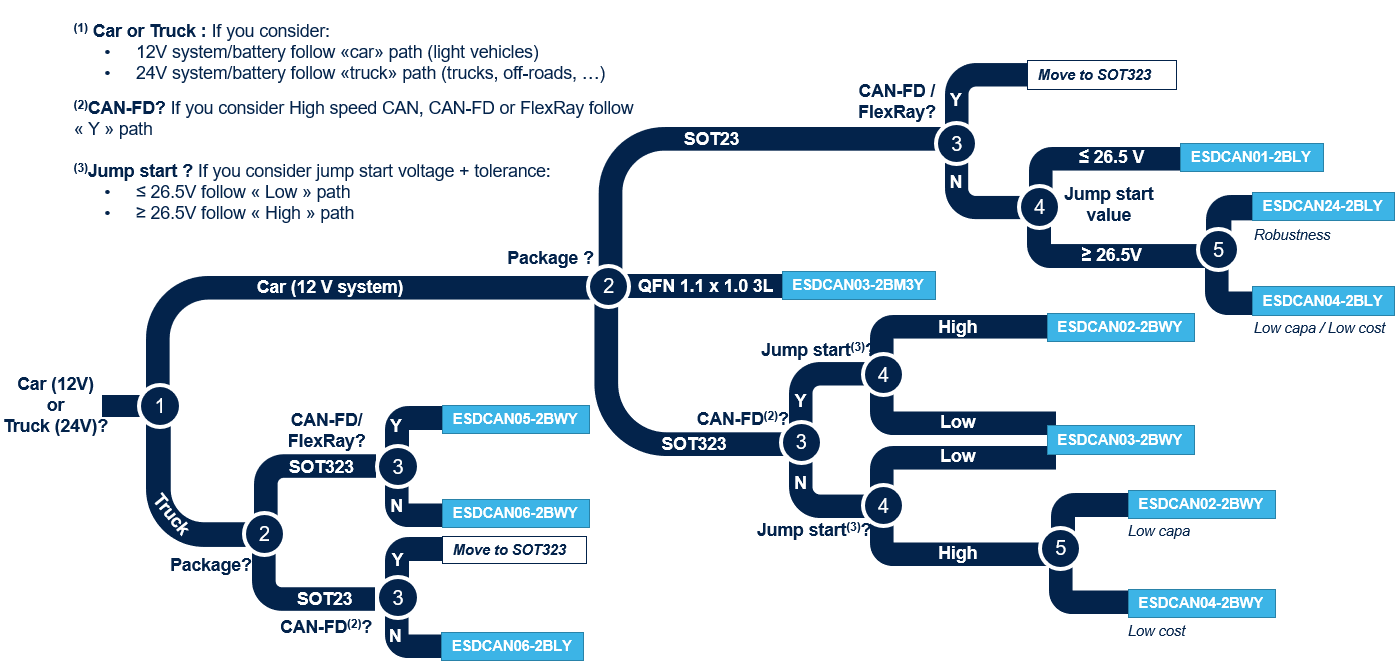To ensure correct operation throughout a vehicle's lifetime in harsh environments, automotive applications must be protected against damaging voltage transients like lightning and electrostatic discharges (ESD) in compliance with ISO standards.
Applications
Why should you use ESD protection in automotive applications?
If there is no protection, ICs generally rated according to Human Body Model (HBM) or Charged Device Model (CDM) standards for their ESD capability, cannot survive the high currents and voltages specified in ISO standards.
For instance, when a circuit becomes damaged, warning lamps will appear in the dashboard and the driver will feel unsafe and will have a bad image of the vehicle’s quality. So, you need reliable and efficient protection against rated automotive surges.
Types of automotive ESD protection
ST's automotive data line ESD protection devices include transient voltage suppressors (TVS) and application-specific discrete devices that provide system level protection against ESD surges according to standard IEC 61000-4-2. ESD protection devices are manufactured using automotive-grade processes and qualified to AEC-Q101 standards. As such, they can address all automotive applications and domains including advanced driver-assistance systems (ADAS), vehicle-to-everything (V2X), CAN-FD, SerDes (serializer/deserializer), and Ethernet Base-T standards to name just a few. Moreover, ST offers innovative, miniature wettable flank DFN packages to ease Automatic Optical Inspection (AOI).
Explore our solutions to protect your latest generation of CAN and LIN transceivers even in the toughest and most integrated PCB environment.
Automotive ESD protection main benefits
- A flexible portfolio that covers a wide range of requirements and applications.
- Easy integration with a large choice of packages including a new tiny 3-lead QFN with wettable flanks (1.1 x 1.0 mm) allowing AOI (Automatic Optical Inspection).
- Simplified designs and layouts thanks to low parasitic capacitance
- High level immunity achieved with the very low clamping voltage

Featured Videos
Recommended for you
FAQ related to ESDCAN
This is a list of frequently asked questions (FAQ) on automotive ESD protection components.
How can I obtain an ESDCAN evaluation board STEVAL-OET003V1?
You can purchase the board directly from the STMicroelectronics eStore or from major online electronics distributors. You can download the data brief here: STEVAL-OET003V1.
What is the maximum communication CAN speed that is compatible with ESDCAN?
Our ESDCAN can address CAN-FD, CAN-FD SiC, and CANXL up to 20Mbps.
Are there other networks in the car besides CAN?
Current vehicle networks include CAN, LIN, FlexRay, MOST, and the new in-vehicle Ethernet. CAN-FD and in-vehicle Ethernet are gaining popularity for more complex and integrated car functions.
Can STMicroelectronics CAN protection be used on any CAN node?
Yes. Whatever the bus topology (star, ring, or any combination), the ESDCAN can be used to protect the CAN transceivers. For long distance CAN buses, we recommend using ESDCAN02, ESDCAN03, or ESDCAN05 with lower parasitic capacitance.
Is the STMicroelectronics ESDCAN series available in automotive grade?
Yes, the whole ESDCAN series is automotive grade. Refer to our official website here: ESDCAN series
What are the effects of ESD protection on the transmission signal and the risks if the protection is not implemented correctly?
ESD discharges may damage CAN protocol chips. Most CAN transceivers are rated (human body model 500 V or 2 kV or 8 kV) for ESD, but most carmakers require compliance above the far stricter ISO 10605 requirements, which are 8 kV contact and 15 kV air discharge. If ESD protection is not implemented correctly, the CAN transceiver may be damaged and all the vehicle functions in the same CAN network may be compromised.

Do you still need to add CAN transceivers and CAN protection on microcontroller CAN ports?
If the MCU embeds a CAN controller only, then a CAN transceiver is needed and must be protected with an ESDCAN. If the MCU embeds a CAN transceiver, then there is no need for an additional chip to interface with the PHY layer, but ESDCAN is needed to protect the embedded CAN transceiver according to ISO 10605 standard and ISO 7637 standard.
Which situations require special attention when implementing CAN buses in automotive electronics?
The automotive environment is complex with many interference sources, so you must pay careful attention to EMC anti-interference and ESD protection. Refer to our application note AN5878 on how to design a robust automotive CAN system.
How many volts can human electrostatic discharges generate?
In the ISO 10605 standard, human ESD discharges are considered up to 15 kV for direct contact discharge. The RC network to be considered is 150 pF and 330 Ω (to simulate discharge through a metallic object like a tool, a key, etc.) or 2 kΩ (to simulate discharge through the skin).
Do ESD protection devices have a leakage current problem? What is the maximum allowable leakage current?
STMicroelectronics ESD leakage current is negligible; usually in the order of nanoampere. Please refer to our product specification (datasheet here: Protections and EMI filters/ESD Protection/Automotive ESD protection: ESDCAN series.
Can ESDCAN also be used in industrial applications?
Certainly. The STMicroelectronics ESD protection capability is higher for automotive products, so our ESD devices are always appropriate for industrial applications.
Are there aging issues on ESDCAN devices like for a MOV?
There is no aging on silicon devices. As long as surges remain below the datasheet rating, the ESDCAN continues to operate without degradation of its characteristics (such as clamping efficiency).
Can you provide more detailed information on ESD protection?
Please refer to this document: Application note AN2689 protection of automotive electronics from electrical hazards, guidelines for design and component selection.
Are the same ESD protection devices used on high-rate and low-rate lines for CAN?
Use the STMicroelectronics low capacitance ESDCAN for high-speed CAN, such as 3 pF and 17 pF. Low speed CAN may use 30 pF, or the same low capacitance devices used for high-speed lines. See ESDCAN01-2BLY, ESDCAN03-2BWY, ESDCAN03-2BM3Y for product details. The first two products have different capacitance values, and the third has low capacitance with a small footprint.
Does the in-vehicle CAN ESD protection work in temperature ranges required in automotive environments?
Yes. ST ESDCAN0x-2BWY and ESDCANx-2BM3Y operate from -55 to +175 °C.
What is the area occupied by an ESDCAN on the PCB?
We offer small SOT23-3L, SOT323-3L, and QFN-3L (also called DFN1110) packages with the following respective footprints in mm:
- 3.1 mm x 2.43 mm
- 2.7 mm x 1.72 mm
- 0.89 mm x 1.31 mm

What level of voltage protection do STMicroelectronics ESD devices offer for CAN?
STMicroelectronics offers a wide range of AEC-Q101 CAN protection devices for passenger cars (12 V batteries) or commercial vehicles (24 V batteries). STMicroelectronics ESDCAN covers fault-tolerant CAN, CAN-FD, LIN, and even FlexRay communication protocols. It can provide 12 V and 24 V.

Is the ESDCAN a single ESD device (chip)?
Yes. Our ESDCAN dual-TVS protection devices embed both CAN_H and CAN_L TVS in the same package.
Are ESDCAN protections compatible with load dump surges?
ESDCAN devices are designed to protect the CAN data lines, which are not subject to load dump surges. Load dump surges must be considered on certain power lines (VBAT lines mainly).
What kinds of elements (chips) need ESDCAN for protection? Can you provide an example of which chips need extra ESDCAN protection?
Our ESDCAN devices are mainly meant to protect CAN transceivers, which are very often made with thin IC technology. However, ESDCAN devices also protect termination resistors and capacitors for MDI (medium dependent interface), which may be affected by ESD pulses or transient surges. As the CAN bus is a differential bus, any spikes on the MDI resistors or capacitors may affect the matching lines and degrade the signal integrity. Our ESDCAN devices ensure that these effects are avoided.







